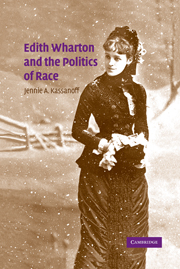Book contents
- Frontmatter
- Contents
- Acknowledgements
- Introduction
- 1 Invaders and Aborigines: playing Indian in the Land of Letters
- 2 “The real Lily Bart”: staging race in The House of Mirth
- 3 “A close corporation”: the body and the machine in The Fruit of the Tree
- 4 The Age of Experience: pragmatism, the Titanic and The Reef
- 5 Charity begins at home: Summer and the erotic tourist
- 6 Coda: The Age of Innocence and the Cesnola controversy
- Notes
- Bibliography
- Index
2 - “The real Lily Bart”: staging race in The House of Mirth
Published online by Cambridge University Press: 22 September 2009
- Frontmatter
- Contents
- Acknowledgements
- Introduction
- 1 Invaders and Aborigines: playing Indian in the Land of Letters
- 2 “The real Lily Bart”: staging race in The House of Mirth
- 3 “A close corporation”: the body and the machine in The Fruit of the Tree
- 4 The Age of Experience: pragmatism, the Titanic and The Reef
- 5 Charity begins at home: Summer and the erotic tourist
- 6 Coda: The Age of Innocence and the Cesnola controversy
- Notes
- Bibliography
- Index
Summary
“But what is your story, Lily? I don't believe any one knows it yet.” Gerty Farish's question, coming as it does near the end of Edith Wharton's 1905 best-seller The House of Mirth, is certainly ironic. Within the context of a novel that labors precisely to tell the whole “story” of Lily Bart, Gerty's question suggests the absence or concealment of the text's central narrative. Lily's response, moreover, is disconcertingly opaque:
“From the beginning?” Miss Bart gently mimicked her. “Dear Gerty, how little imagination you good people have! Why, the beginning was in my cradle, I suppose – in the way I was brought up, and the things I was taught to care for. Or no – I won't blame anybody for my faults: I'll say it was in my blood, that I got it from some wicked pleasure-loving ancestress, who reacted against the homely virtues of New Amsterdam, and wanted to be back at the court of the Charleses!”
(House 226)Lily decides that her flaws are not the work of environment alone; they are also the result of hereditary traits “in [the] blood,” passed down from a sybaritic ancestress. Such logic represents a prime example of what Laura Otis calls “organic memory” – the belief that “repeated patterns of sensations, whether of the recent or distant past, had left traces in the body, making the individual an epitome of his or her racial history” (3).
- Type
- Chapter
- Information
- Edith Wharton and the Politics of Race , pp. 37 - 58Publisher: Cambridge University PressPrint publication year: 2004



